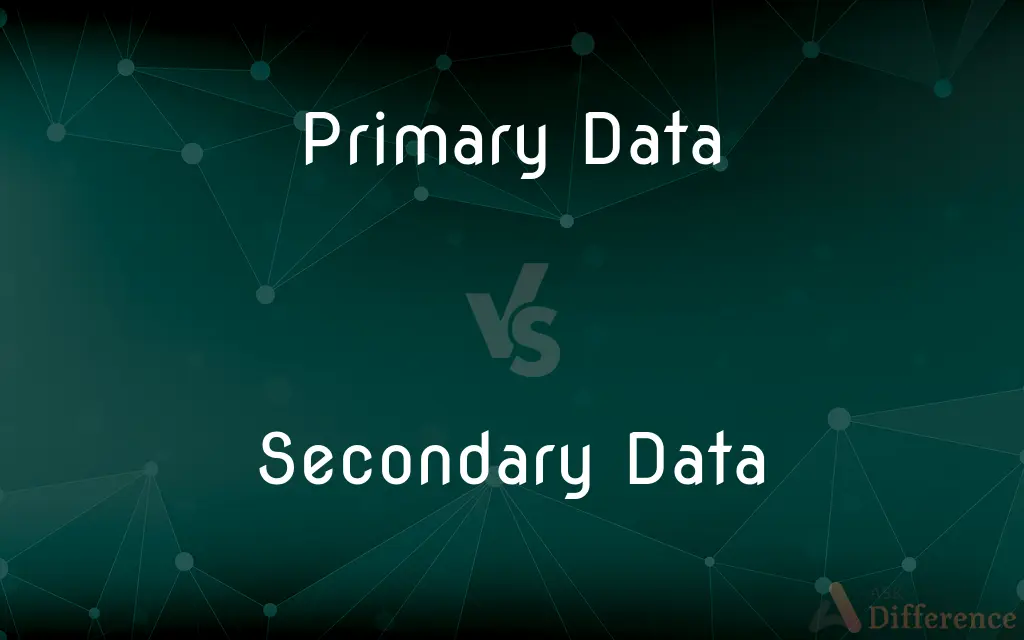Primary Data vs. Secondary Data — What's the Difference?
Edited by Tayyaba Rehman — By Fiza Rafique — Published on December 17, 2023
Primary Data is collected firsthand for a specific purpose, while Secondary Data is previously gathered data used for a new research purpose.

Difference Between Primary Data and Secondary Data
Table of Contents
ADVERTISEMENT
Key Differences
Primary Data and Secondary Data serve as pillars in the research realm. Primary Data is the information researchers obtain directly from the source, tailored for a particular study. Surveys, interviews, and direct observations often yield this firsthand data. In contrast, Secondary Data is information that has already been collected and exists prior to the current research. Libraries, online databases, and published reports are typical reservoirs of such data.
Thinking about Primary Data, it offers freshness and specificity, directly relevant to the research at hand. For example, a company launching a new product might collect Primary Data by surveying potential customers about their preferences. On the other hand, Secondary Data can be likened to reusing existing information. A business might consult industry reports, previously collected, to understand market trends.
While Primary Data provides a direct lens into the topic, it can be time-consuming and often expensive to gather. Secondary Data, being readily available, offers a cost-effective, time-saving option, though it might not perfectly align with the current research needs.
In sum, Primary Data emerges from direct, firsthand sources, tailor-made for the specific research, whereas Secondary Data is pre-existing information repurposed for new inquiries.
Comparison Chart
Source
Directly from the source.
Pre-existing sources.
ADVERTISEMENT
Relevance
Specific to the current research.
General and not specifically tailored.
Collection Method
Surveys, interviews, direct observations.
Libraries, databases, published reports.
Time and Cost
Often time-consuming and costly.
Time-saving and cost-effective.
Freshness
Fresh and up-to-date.
May be outdated or not perfectly aligned.
Compare with Definitions
Primary Data
Primary Data is collected directly for a specific research purpose.
The company conducted a survey to gather Primary Data about customer preferences.
Secondary Data
Secondary Data offers a broader perspective, not tailor-made for a specific research.
The team utilized market reports as Secondary Data to understand past trends.
Primary Data
Primary Data is tailored to the unique requirements of a study.
The experimental results served as Primary Data for the thesis.
Secondary Data
Secondary Data is readily available and often cost-effective.
The student accessed online databases to gather Secondary Data for her project.
Primary Data
Primary Data emerges from contemporary observations or interactions.
The fieldwork in the rainforest produced Primary Data on local flora.
Secondary Data
Secondary Data encompasses data previously used in other research or for other purposes.
Historical archives served as a rich source of Secondary Data for the documentary.
Primary Data
Primary Data originates from firsthand sources and experiences.
Direct interviews provided the team with invaluable Primary Data.
Secondary Data
Secondary Data is derived from sources that existed before the current study.
Published research papers provided a wealth of Secondary Data.
Primary Data
Primary Data offers a direct lens into the research subject.
The focus group discussions yielded Primary Data on user behavior.
Secondary Data
Secondary Data is pre-collected information used for new research.
The scholar used census reports as Secondary Data for his demographic study.
Common Curiosities
Can Secondary Data be used as a basis for Primary Data?
Yes, Secondary Data can provide background or context, guiding the collection of Primary Data.
Which type of data, Primary or Secondary, is more time-consuming to collect?
Primary Data is generally more time-consuming to collect compared to Secondary Data.
Is Primary Data always more reliable than Secondary Data?
Not necessarily. Both can be reliable, but Primary Data is often more specific to the research at hand.
What's the main distinction between Primary Data and Secondary Data?
Primary Data is firsthand information collected for specific research, while Secondary Data is pre-existing data repurposed for new research.
Where can I typically find Secondary Data?
Secondary Data can be found in libraries, online databases, published reports, and more.
Is data from government databases considered Primary or Secondary?
If you're using it for research other than its original purpose, it's considered Secondary Data.
What's an example of a Primary Data collection method?
Direct interviews, surveys, and observations are common methods to collect Primary Data.
Are online surveys a source of Primary or Secondary Data?
Online surveys, when conducted for specific research, yield Primary Data.
If I collect data today and use it for another study next year, is it Primary or Secondary Data next year?
It becomes Secondary Data when used for another study in the future.
Which is typically more expensive to gather: Primary Data or Secondary Data?
Gathering Primary Data is often more expensive than accessing Secondary Data.
Can outdated information be considered Secondary Data?
Yes, as long as it was collected previously and is being used for new research, it's Secondary Data.
Can Secondary Data complement Primary Data in research?
Absolutely. Many researchers use Secondary Data to provide context or background to their Primary Data.
Is Secondary Data always general in nature?
Not always, but it's not specifically tailored for new research, making it more general than Primary Data.
Which type of data is more specific: Primary or Secondary?
Primary Data is usually more specific since it's tailor-made for the research at hand.
Can I trust the accuracy of Secondary Data?
It's crucial to evaluate the source and relevancy of Secondary Data before using it in research.
Share Your Discovery

Previous Comparison
Benzene vs. Cyclohexene
Next Comparison
Open Questions vs. Closed QuestionsAuthor Spotlight
Written by
Fiza RafiqueFiza Rafique is a skilled content writer at AskDifference.com, where she meticulously refines and enhances written pieces. Drawing from her vast editorial expertise, Fiza ensures clarity, accuracy, and precision in every article. Passionate about language, she continually seeks to elevate the quality of content for readers worldwide.
Edited by
Tayyaba RehmanTayyaba Rehman is a distinguished writer, currently serving as a primary contributor to askdifference.com. As a researcher in semantics and etymology, Tayyaba's passion for the complexity of languages and their distinctions has found a perfect home on the platform. Tayyaba delves into the intricacies of language, distinguishing between commonly confused words and phrases, thereby providing clarity for readers worldwide.
















































